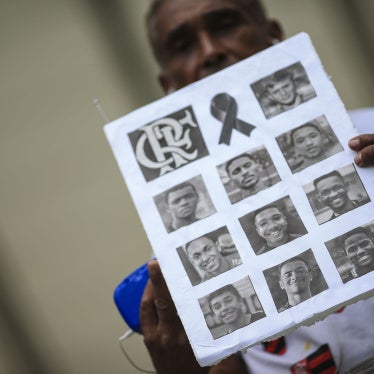By Joanne Mariner, Deputy Director of Human Rights Watch's Americas Division
Published in FindLaw.com
September 29, 2003
When Paula Calderón was fourteen, her mother died. A few weeks after the funeral, Paula’s father brought her to a guerrilla outpost in the jungle. “He told me that he had a debt with them,” she said when I interviewed her last year, “and that he had to hand me over in exchange.”
Paula ended up spending a year and a half with the Cimarones Resistance Front of the National Liberation Army, known as the ELN. Some 200 guerrillas belonged to her unit, the large majority of whom were teenagers like her. “The youngest were around eleven years old,” she remembered, “but most were age 14, 15, or so.”
All of the irregular armed forces in Colombia’s decades-old war -- left-wing guerrillas and right-wing paramilitaries -- send child soldiers of Paula’s age into combat. When I met Paula at the government rehabilitation center where she lived, she showed me how her stomach was a mass of gruesome scars, the result of having been shot during fighting with paramilitaries. The nurse who was treating her said that Paula was lucky to be alive, since the wound had become infected due to improper medical treatment.
Because underage combatants fill the ranks of both guerrilla and paramilitary groups, many of the dead and wounded in the armed conflict are children. And even those who are unscathed physically are likely to bear psychological scars.
To exploit children in this way is not simply cruel, it is a war crime.
One of Every Four Combatants Under Age 18
At least one of every four irregular combatants in Colombia is under eighteen years of age. According to a new report by Human Rights Watch, the total number of child combatants in Colombia likely exceeds 11,000. The youngest join up at age seven or eight, while most are recruited as young adolescents, at age twelve or thirteen.
Unlike Paula, most child soldiers in Colombia are not forced into joining. Still, the intense pressures they often face and lack of opportunities in their lives undercut the idea that they join voluntarily.
Most are from desperately poor backgrounds, with little chance of education, personal advancement, or status. Many were abandoned by their parents or farmed out to relatives. Some are victims of domestic violence or sexual abuse. Frequently, by the time they enter their teens, they have left school and are working at menial, poorly-paid jobs.
“When I was twelve, a cousin raped me,” one girl told me, explaining why she left home for the guerrillas. “I was so angry, I wanted vengeance. I wanted to hurt everyone who had hurt me.”
Killing, Mutilation and Torture
Once these children enter a guerrilla or paramilitary group, they lose whatever tenuous claim they may have had on childhood. The life of children in these forces is very much like that of adults, with little accommodation made for their age.
Trained to use modern assault rifles from the age of eleven, young recruits march for days on end with little food. Many die or are wounded in battles with government soldiers backed by helicopters and heavy artillery.
And it is not just on the battlefield that these children see death. Besides taking part in combat, they are also expected to take part in the atrocities that are a hallmark of the Colombian conflict. Human Rights Watch interviewed former child soldiers who, as trainees, were forced to watch captives being tortured and mutilated. Others were made to shoot unarmed prisoners as a test of valor. Still others were ordered to execute comrades -- even friends - who were captured while trying to run away.
The Use of Child Soldiers is a War Crime
By sending children into battle, guerrillas and paramilitaries are committing war crimes. Under Protocol II to the Geneva Conventions, groups fighting an internal armed conflict are prohibited from recruiting children under the age of fifteen, or allowing them to take part in hostilities. The Convention on the Rights of the Child (CRC), ratified by all U.N. member states except for the United States and Somalia, also establishes fifteen as the minimum permissible age for military recruitment.
Because the CRC’s general definition of a child is any person under the age of eighteen, its rule on the age for military recruitment is an anomaly. The Optional Protocol to the Convention, which came into force last year, corrected this difference. It prohibits the compulsory military recruitment of anyone younger than eighteen and bars irregular armed groups from recruiting under-eighteen-year-olds or using them in combat.
Lost Years
“Four lost years,” said Jorge, a sixteen-year-old boy, when I asked him to sum up his experiences in the paramilitaries. “Four years of seeing friends die.”
Too many number of children have fought and died in Colombia. If the adults who are responsible for the war are not willing to end it, they should at least do the fighting themselves.








